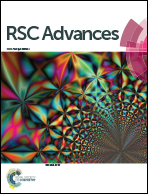Control of magnetic field distribution by using nickel powder@PDMS pillars in microchannels†
Abstract
A simple and robust approach to control the magnetic field distribution by nickel powder@PDMS pillars was established. The nickel powder@PDMS pillars were fabricated in several simple steps, using a simple and robust method, and no training in techniques or expensive equipment is necessary compared to other methods. The localized magnetic field distributions in microchannels can be tailored by the nickel powder@PDMS pillars with automatic generation of high magnetic field gradients around them due to the high relative magnetic permeability of the nickel powder@PDMS. The numerical simulation and red fluorescent magnetic nanoparticle capture experiment results convinced us that our approach could effectively control the localized magnetic field distribution in the microchannels. Two kinds of tailoring events were studied at the powder@PDMS pillars in the microchannels underneath two different external magnetic fields. To the best of our knowledge, this is the first time different localized magnetic field distributions have been obtained in microchannels by nickel powder@PDMS pillars due to different external magnetic fields. This approach was used to capture fluorescent magnetic nanoparticles and magnetic bead–yeast cell complexes. We believe that this approach has great potential applications in chemistry, biology, biomedicine and tissue engineering.


 Please wait while we load your content...
Please wait while we load your content...